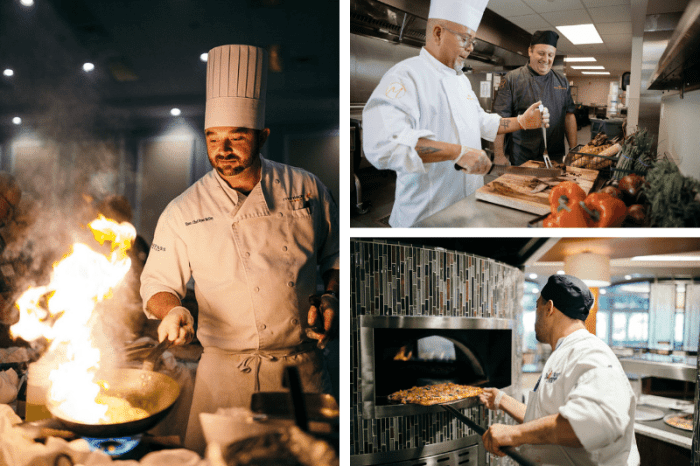
Sustainable Sourcing and Production: Sustainability In Culinary Culture
Sustainable sourcing and production are crucial in the culinary culture for ensuring the availability of ingredients in the future and minimizing environmental impact.
Sustainability in culinary culture – Sourcing ingredients from sustainable sources means obtaining them from suppliers who prioritize environmentally friendly practices, such as reducing waste, conserving water, and using renewable energy. By supporting sustainable suppliers, culinary professionals can contribute to preserving natural resources and protecting ecosystems.
Local and Seasonal Produce
Local and seasonal produce is an excellent choice for sustainable sourcing. By choosing ingredients grown close to the restaurant or within the region, transportation emissions are reduced. Seasonal produce is naturally ripe and flavorful, requiring less energy for preservation and storage. Additionally, supporting local farmers strengthens the community and preserves traditional farming practices.
Global Food Chains
Global food chains, while providing access to a wider variety of ingredients, pose challenges to sustainability. Long-distance transportation contributes to greenhouse gas emissions, and the use of pesticides and fertilizers in industrial agriculture can harm the environment. Culinary professionals can mitigate these impacts by carefully considering the environmental footprint of their supply chain and opting for suppliers who prioritize sustainable practices.
Sustainable Farming and Fishing Practices
Sustainable farming and fishing practices minimize environmental impact and ensure the long-term viability of food sources. Examples include:
- Organic farming: Eliminates the use of synthetic pesticides and fertilizers, preserving soil health and reducing water pollution.
- Aquaculture: Managed fish farming can reduce pressure on wild fish populations while providing a sustainable source of seafood.
- Regenerative agriculture: Focuses on improving soil health, increasing biodiversity, and capturing carbon dioxide from the atmosphere.
Waste Reduction and Management
Culinary operations generate a staggering amount of food waste, contributing significantly to environmental pollution and resource depletion. Reducing food waste is crucial for promoting sustainability in culinary culture.
Practical solutions for reducing food waste include:
- Implementing inventory management systems to track and reduce spoilage.
- Educating staff and customers about waste reduction practices.
- Donating surplus food to food banks or shelters.
- Composting food scraps and using them as natural fertilizer.
Innovative Technologies and Practices for Composting and Recycling
Innovative technologies and practices are revolutionizing food waste management:
- Composting machines: These machines accelerate the composting process, reducing the time and space required.
- Anaerobic digestion: This process converts food waste into biogas, which can be used as a renewable energy source.
- Waste-to-energy plants: These facilities incinerate food waste to generate electricity.
Energy Efficiency in Culinary Operations
Energy efficiency is crucial in kitchens and restaurants, significantly reducing operating costs and environmental impact. By adopting energy-efficient practices, culinary operations can minimize energy consumption while maintaining productivity and quality.
Energy-efficient cooking equipment, such as induction stoves and convection ovens, utilize less energy than traditional counterparts. Induction stoves heat cookware directly, eliminating heat loss to the surrounding environment. Convection ovens circulate hot air, ensuring even cooking and reducing energy consumption.
Lighting systems also contribute to energy efficiency. LED lighting consumes significantly less energy than incandescent or fluorescent bulbs and lasts longer, reducing maintenance costs.
Refrigeration technologies, such as high-efficiency compressors and well-insulated cabinets, minimize energy consumption. Regular maintenance and proper temperature monitoring prevent energy wastage.
Sustainable Menu Design

Menu design plays a pivotal role in promoting sustainability within culinary culture. By thoughtfully curating menus, chefs can influence diners’ choices, educate them about sustainable food practices, and reduce the environmental impact of their operations.
Seasonal and Local Ingredients
Featuring seasonal and locally sourced ingredients on menus is a cornerstone of sustainable menu design. Seasonal produce is harvested at its peak ripeness, reducing transportation emissions and ensuring optimal flavor and nutritional value. Local sourcing supports nearby farmers, reduces food miles, and fosters connections within the community.
Sustainably Sourced Ingredients
Chefs can also promote sustainability by choosing ingredients that are sustainably sourced. This includes opting for seafood certified by organizations like the Marine Stewardship Council, or purchasing meat and poultry from farms that prioritize animal welfare and environmental stewardship.
Educating Diners
Menu design can serve as an educational tool, informing diners about the sustainability practices behind the dishes they order. By providing clear descriptions and labeling sustainable choices, chefs can empower diners to make informed decisions and support responsible food production.
Examples of Sustainable Menus, Sustainability in culinary culture
Numerous restaurants worldwide have embraced sustainable menu design. For example, “The Perennial” in San Francisco offers a seasonally changing menu that showcases local, organic, and sustainably sourced ingredients. “Zero Waste Bistro” in New York City specializes in dishes made from ingredients that would otherwise go to waste, promoting both sustainability and creativity.
Education and Awareness

Promoting sustainability in culinary culture requires a concerted effort to educate and raise awareness among chefs, restaurateurs, and consumers. Understanding the environmental and social impacts of food production and consumption is crucial for fostering responsible practices.
Programs and Initiatives
- Culinary schools and training programs are incorporating sustainability into their curricula, equipping future chefs with knowledge and skills to make sustainable choices.
- Non-profit organizations, such as the Sustainable Restaurant Association, offer certification programs to recognize and promote restaurants that demonstrate sustainable practices.
- Government initiatives, like the USDA’s Farm to School program, connect farmers with schools to promote local and sustainable food sourcing.
Media and Social Media
Media outlets and social media platforms play a vital role in disseminating information about sustainability issues and promoting responsible practices. Documentaries, news articles, and social media campaigns can raise awareness and inspire action among consumers.